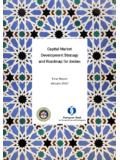Transcription of OECD Economic Surveys JAPAN
1 OECD Economic Surveys JAPAN . APRIL 2015. OVERVIEW. This document and any map included herein are without prejudice to the status of or sovereignty over any territory, to the delimitation of international frontiers and boundaries and to the name of any territory, city or area. The statistical data for Israel are supplied by and under the responsibility of the relevant Israeli authorities. The use of such data by the OECD is without prejudice to the status of the Golan Heights, East Jerusalem and Israeli settlements in the West Bank under the terms of international law. @ OECD 2015 2. OECD Economic Surveys : JAPAN OECD 2015. Executive summary Main findings Key recommendations 9. @ OECD 2015 3. EXECUTIVE SUMMARY. Main findings Two decades of sluggish growth and persistent deflation have reduced Japanese living standards below the OECD average. Gross government debt has risen to 226% of GDP, the highest in the OECD, driven by rising social spending and inadequate revenues.
2 Rapid population ageing is putting continued pressure on public spending, while pushing down JAPAN 's potential growth rate to around per cent. Abenomics bold monetary policy, flexible fiscal policy and a growth strategy to revitalise the economy and end deflation . had an immediate positive effect in 2013, thanks to the first two arrows. Growth was interrupted in the wake of the tax increase in April 2014, but resumed later in the year. JAPAN 's debt is the highest in the OECD, pushing up debt service costs A. JAPAN 's debt-to-GDP ratio is high (2014) B. Central government budget (FY 2015). Per cent of GDP. 250. Health and long-term care National debt service . 200. 150. Pensions and other 100 social spending 50 Other 0 Transfers to local ITA. EST. JPN. NOR. GRC. DEU. CAN. ESP. FRA. PRT. OECD. SWE. KOR. GBR. USA. governments 1. Debt service includes debt redemption, which is not included in general government spending. Source: OECD Economic Outlook Database; Ministry of Finance.
3 1 2 Boost Economic growth through bold structural reforms. Fundamental structural reforms the third arrow urgently need to be stepped up to raise output growth, which is essential for fiscal consolidation and improved living standards. The role of women is limited by a range of factors, including their concentration in non-regular jobs and disincentives in the tax system. JAPAN remains internationally isolated with the lowest share of inward foreign direct investment (as a per cent of GDP) in the OECD area. Low rates of firm creation and exit reflect a lack of Economic dynamism in the business sector. Venture capital investment is at an early stage of development and the small and medium-sized enterprise sector is lagging. The top fiscal priority is reducing government debt. With a primary deficit of nearly 7%. of GDP in 2014, public debt remains on an upward path. The impact of the high debt is mitigated by low long-term interest rates, but weakening confidence would cause interest rates to rise substantially.
4 A run-up in interest rates would increase debt rapidly and destabilise the financial sector and the real economy. Large-scale revenue increases are indispensable, although this will tend to temporarily hold back GDP growth. Constraining spending is difficult but crucial, given upward pressure on social outlays, notably for health and long-term care, and the need to promote social cohesion. Social spending, which is concentrated on the elderly, has only a limited impact on income inequality among the working-age population, whose relative poverty rate increased through 2012. This partly reflects the rising share of non- regular workers, who are paid much less than regular workers. End deflation. Persistent deflation has been a headwind to growth and has exacerbated the fiscal situation by steadily reducing nominal GDP. The Bank of JAPAN has set a 2% inflation target and launched quantitative and qualitative monetary easing , boosting its balance sheet to 65% of GDP.
5 10 OECD Economic Surveys : JAPAN OECD 2015. @ OECD 2015 4. EXECUTIVE SUMMARY. Key recommendations Effective implementation of all three arrows of Abenomics is required for its success Boost Economic growth through bold structural reforms The top priorities in this regard are to: Slow the trend decline in the labour force by: Increasing female employment by expanding childcare, reforming aspects of the tax and social security systems that reduce work incentives for second earners and breaking down labour market dualism to reduce gender inequality. Expanding the use of foreign workers. Participate in high-level trade agreements, notably the Trans-Pacific Partnership and a JAPAN -EU Economic Partnership Agreement. Improve the business climate to boost productivity growth by: Upgrading corporate governance. Promoting labour market flexibility and mobility. Improving the entrepreneurial climate by ensuring second chances and developing entrepreneurial education.
6 Revitalising venture capital investment to promote firm creation and innovation. Reducing government support for SMEs to promote the restructuring of viable firms and the exit of non-viable ones. Moving to a more market-based agricultural system by measures such as reducing commodity-specific payments to farmers, accelerating the consolidation of farmland and reforming the role of agriculture co-operatives. The top fiscal priority is reducing government debt while promoting social cohesion Set out a detailed and credible plan to constrain government spending and raise revenues so as to achieve the target of a primary surplus by FY 2020. Rely primarily on the consumption tax with a single rate and a broadening of the personal and corporate income tax base to boost government revenue, while raising environmental taxes. Reform pension and health and long-term care to limit spending growth in the face of population ageing. Improve the targeting of public social spending and introduce an earned income tax credit for low-income workers.
7 Break down labour market dualism by increasing the coverage of social insurance and upgrading training programmes for non-regular workers, and reducing effective employment protection for regular workers, in particular by increasing transparency. End deflation Continue monetary expansion to durably raise inflation to the 2% target, while monitoring risks. OECD Economic Surveys : JAPAN OECD 2015 11. @ OECD 2015 5. @ OECD 2015 6. OECD Economic Surveys : JAPAN OECD 2015. Assessment and recommendations Recent macroeconomic developments and short-term prospects Structural reforms to boost growth: The JAPAN Revitalisation Strategy (the third arrow). Reducing government debt: Flexible fiscal policy (the second arrow). Ending deflation: Bold monetary policy (the first arrow). 13. @ OECD 2015 7. ASSESSMENT AND RECOMMENDATIONS. D uring the past two decades, Economic growth has been sluggish, reducing JAPAN 's relative per capita income from a level matching the top half of OECD countries in the early 1990s to 14% below (Figure 1).
8 The collapse of the asset price bubble in the early 1990s was followed by an extended period of corporate restructuring and a banking crisis. Weak growth has contributed to JAPAN 's serious fiscal problem by limiting the growth of government revenue. Rising spending, driven by population ageing and frequent fiscal stimulus packages, has been financed largely by borrowing, boosting gross government debt to 226% of GDP in 2014 (Panel B), the highest ever recorded in the OECD. Net debt is also the highest at 129% of GDP. Upward pressure on the debt ratio continues, with a primary budget deficit of nearly 7% of GDP in 2014 (Panel C). Persistent deflation has contributed to the run-up in the debt ratio by reducing nominal GDP (Panel D), while acting as a headwind to output growth. The 2011 Great East JAPAN Earthquake the worst disaster in JAPAN 's post-war history put further pressure on public finances. In early 2013, JAPAN launched a three-pillar approach, the so-called three arrows of Abenomics , to exit deflation and revitalise the country: a bold monetary policy; flexible fiscal policy; and a growth strategy.
9 The first arrow was launched in early 2013 with the introduction of quantitative and qualitative easing (QQE). It was accompanied by the second arrow, which included two large fiscal packages. The third arrow the JAPAN Revitalisation Strategy was announced in June 2013 and revised a year later. The combined effects of fiscal and monetary policy expansion and structural reform were intended to strengthen business investment and private consumption, with a view to boost real growth to a 2% annual pace through 2022 and to achieve a 2% inflation target. The initial results of the first two arrows were encouraging; nominal GDP increased at a faster pace, aided by a pick-up in inflation, reflecting a large depreciation of the yen. Output growth reached in 2013, as business and consumer confidence soared and the stock market rose by 57%. Following a contraction in the wake of the consumption tax hike, growth resumed in late 2014.
10 The third arrow of Abenomics is its most crucial component, without which the unprecedented monetary expansion and the fiscal effort will not succeed in putting JAPAN on a path to faster growth and fiscal sustainability. The ten key reforms in the Strategy include important measures to promote growth, but they need to be more ambitious and implemented rapidly. The top priorities are: i) stabilising the size of the labour force by boosting the participation of women and older people and expanding inflows of foreign workers; ii) enhancing JAPAN 's integration in the world economy through trade agreements, notably the Trans-Pacific Partnership (TPP) and the JAPAN -EU Economic Partnership Agreement; and iii) improving the business climate by upgrading corporate governance, enhancing labour flexibility and mobility, promoting venture capital investment and improving policies for small and medium-sized enterprises (SMEs). The key messages in this survey are: Bold structural reforms are crucial to boost JAPAN 's growth potential.













